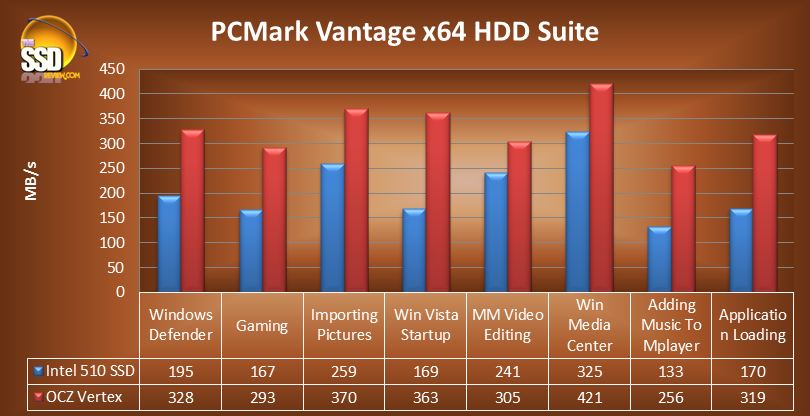PCMARK VANTAGE HDD SUITE
The SSD Review uses benchmark software called PCMark Vantage x64 HDD Suite to create testing scenarios that might be used in the typical user experience. There are eight tests in all and the tests performed record the speed of data movement in MB/s to which they are then given a numerical score after all of the tests are complete. The simulations are as follows:
- Windows Defender In Use
- Streaming Data from storage in games such as Alan Wake which allows for massive worlds and riveting non-stop action
- Importing digital photos into Windows Photo Gallery
- Starting the Vista Operating System
- Home Video editing with Movie Maker which can be very time consuming
- Media Center which can handle video recording, time shifting and streaming from Windows media center to an extender such as XBox
- Cataloging a music library
- Starting applications
INTEL SERIES 510 250GB SSD VANTAGE X64 RESULTS
The Intel 510 scored a high of 42934 which is a great mark but a little less than we expected. Less than 6 months ago, there wasn’t a SSD out there that could reach the 40000 plateau of Vantage HDD Suite so this definitely shows us the direction in which we are moving. In taking a look at the chart below, however, one might ask the question as to why there are upper tier SATA 2 drives with much lower high sequential performance scores and better Vantage scoring.Lets do a comparison against the new OCZ Vertex 3 first:
As the 8 tests of Vantage are based on real typical user computing patterns, Vantage gives very little weight to the high sequential transfer speeds that are hardly ever used and elects to rely upon 4k random reads and writes for the majority of point calculation. This is because we use these disk access methods over 50% of the time where we use the high sequential disk access methods less than 1%.
CONCLUSIONS
We have to say that this SSD is certainly a capable SSD for those who have specifically waited for Intel to enter the fold with their first SATA 3 entry. We have nothing but praise for any drive that breaches the 40000 point mark in our PCMark Vantage HDD Suite but, for a newly released SATA 3 drive with such high synthetic benchmarks, we honestly expected more. This drive sits within many of the upper tier SATA 2 drives that we have evaluated and, with the IOPS specifications that they have provided, we can’t help but think of this to be a solid entry as Intels mid-level SSD.
With respect to price, the consumer should be aware that new release SSDs bear the burden of inflated prices to offset production startup costs. At the same time though, industry needs to understand that a happy medium should be found as even the most loyal Intel fan will move to a faster rated drive which sells for less. The price tags of $614 for the 250GB version and $314 for the 120GB version won’t cut it for a mid-level SATA 3 SSD with the likes of SandForce oems just about to hit the street and charging less for mind blowing performance in the SF-2000 drives. We can also expect lower price tags for virtually identical Marvell controlled SSDs just about to be released by the likes of Crucial, Corsair, Patriot and SuperTalent.
Alas those, its an Intel right and, at the moment, its the only new release SATA3 SSD that can be had right now.
On a bit of a side note, we believe Intel is holding another release close to its heart, this being a SSD that will make up their ‘enthusiast’ or enterprise level entry and it will consist of the SF-2200 series processor capable of parallel 500MB/s read and write transfer speeds. We spoke of it in this article and hope to have a follow up article soon.
Intel has publicly stated that, as successful and popular as their proprietary controller was in the X-25 series, they only followed that direction as outside controller manufacturers did not quite fit their design back then. Today Corsair, Patriot, SuperTalent and many other oems have invested heavily to offer the consumer the best in both Marvell and SandForce controlled SATA 3 SSDs.
Why wouldn’t the most relied upon name in computer technology do exactly the same?
PG 1 – INTRODUCTION
PG2 – INTERIOR DESIGN AND BENCHMARK PROTOCOL
PG3 – INITIAL TESTING
PG4 – BENCHMARK TESTING
 The SSD Review The Worlds Dedicated SSD Education and Review Resource |
The SSD Review The Worlds Dedicated SSD Education and Review Resource | 


Why doesn’t your review measure performance before and after the disk is completely written to a few times? Does this Marvell controller compare against the SandForce 12xx series w/r/t ensuring stellar performance after the drive has been abused by filling it over and over with small writes? If it were SandForce-driven, we wouldn’t have to worry. But with anything else….
SITE RESPONSE: The unfortunate part of reviews is that, especially with the onset of SATA 3 right now, we haven’t got the opportunity to spend on time intensive reviews so we do our best. That is why its best that oems provide several reviewers with samples; it allows for variety in testing.
Something I find amusing though is that this is the first time I have ever heard someon make this statement on this side of the fence as it has always been aimed at SF drives in the past.